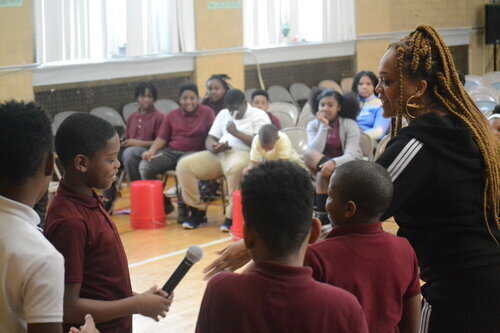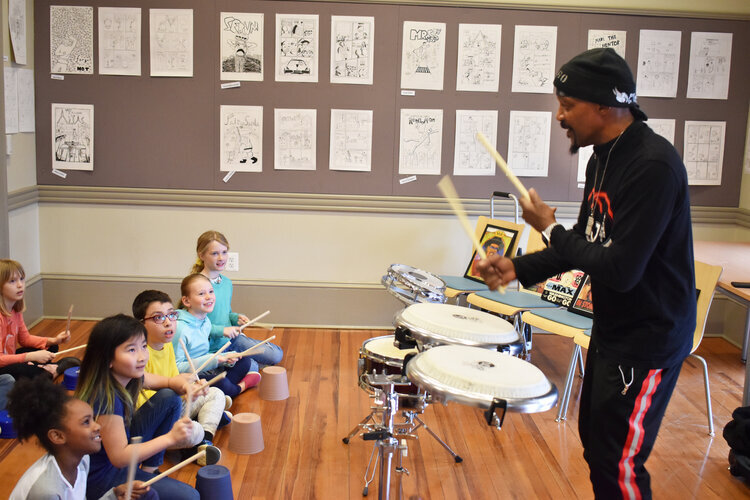HOSTING A CLASSROOM VISIT
OVERVIEW | CLASSROOM VISITS | HOSTING A VISIT | LESSONS | SEMINARS
Go-Go Visit Guidelines
Teach the Beat: Go-Go Goes to School is designed to ensure that students learn the rich history and the various stylistic elements related to the go-go music genre, drawing on the vast array of performers in D.C., scholars, and the experience of teachers who grew up with go-go. The visits are designed to engage students in learning about go-go. They are not performances, although of course they are joyful. The go-go artists we work with have experience in classrooms from pre-K to 12. This will be ideal for:
Music teachers who want to learn more about the musical aspects of go-go
Music teachers or band leaders who want professional feedback for their students as they play go-go
Social studies or language arts teachers who are attempting to include go-go in the curriculum and have questions for experts in the field and/or would like a guest presenter
Contact Teaching for Change to learn more about bringing a go-go musician or scholar to your classroom.
PREPARATION FOR GUEST VISIT
1) Prior to the visit, teachers should do some type of activity to give students background on go-go. The more teachers prepare prior to the artists visits, the more students will gain from the experience. Here are a few options for ways to build background knowledge of go-go:
Read a chapter from The Beat: Go-Go Music from Washington, D.C.
Read a chapter from Go-Go Live: The Musical Life and Death of a Chocolate City
Show a video clip of the artist who will be coming to your classroom
Conduct an interview with someone who listened to go-go growing up in DC in the 80’s
2) Prior to the visit, have your students brainstorm some questions to ask the artist. One activity that you could use is the question formulation technique. (See below for guided steps.)
3) Things to discuss with the artist/presenter ahead of time:
Goals for the class
Available instruments
Student playing ability/background knowledge
Number of students
Length of period
Number of classes
DAY OF GUEST VISIT
Please confirm any final and logistical details with the artist/presenter. Ensure that your students have done a background knowledge assignment and developed their own questions. The following agendas are examples of artist/presenter visits based on high quality visits of go-go artists to DC classrooms. You may work with the artist that is visiting your class to come up with a different plan.
Sample one hour music class:
Brief background on the initiative and sponsors (TFC, DC Commission, and DCPS)/ if age appropriate (1 min.)
Introduction of go-go artist by teacher or student (1 min.)
Overview of go-go history by visiting artist (5-10 min.)
Students play one go-go selection (5 min.)
Go-go artists play one selection (5 min.)
Class separates into teams. Each team given a melody to play on its own. During this time, the artist coaches each group on their technique. (20 min.)
Class plays with artist (10 min.)
Wrap up/group picture (2 min.)
Sample one hour social studies class:
Brief background on the initiative and sponsors (TFC, DC Commission, and DCPS)/ if
Introduction of go-go artist by teacher or student (1 min.)
Overview of go-go history by visiting artist (25 min.)
Wrap up/group picture (5 min.)
AFTER GUEST VISIT
We will ask you to complete a follow up survey about the impact of the visit and any recommendations you have for our project. This is required for all visits.
Question Formulation Technique Six Key Steps
Step 1: Teachers Design a Question Focus.
The Question Focus, or QFocus, is a prompt that can be presented in the form of a statement or a visual or aural aid to focus and attract student attention and quickly stimulate the formation of questions. The QFocus is different from many traditional prompts because it is not a teacher’s question. It serves, instead, as the focus for student questions so students can, on their own, identify and explore a wide range of themes and ideas. In preparation for the visits, we suggest one of the following prompts:
Go-Go is Washington’s unique personality.
You can’t understand DC history if you don’t know about Go-Go.
Go-Go is to DC as jazz is to New Orleans.
Step 2: Students Produce Questions.
Students use a set of rules that provide a clear protocol for producing questions without assistance from the teacher. The four rules are: ask as many questions as you can; do not stop to discuss, judge, or answer any of the questions; write down every question exactly as it was stated; and change any statements into questions. Before students start generating their questions, the teacher introduces the rules and asks the students to think about and discuss possible challenges in following them. Once the students get to work, the rules provide a firm structure for an open-ended thinking process. Students are able to generate questions and think more broadly than they would have if they had not been guided by the rules.
Step 3: Students Improve Their Questions.
Students then improve their questions by analyzing the differences between open- and closed-ended questions and by practicing changing one type to the other. The teacher begins this step by introducing definitions of closed- and open-ended questions. The students use the definitions to categorize the list of questions they have just produced into one of the two categories. Then, the teacher leads them through a discussion of the advantages and disadvantages of both kinds of questions. To conclude this step, the teacher asks the students to change at least one open-ended question into a closed-ended one, and vice versa, which leads students to think about how the phrasing of a question can affect the depth, quality, and value of the information they will obtain.
Step 4: Students Prioritize Their Questions.
The teacher, with the lesson plan in mind, offers criteria or guidelines for the selection of priority questions. In an introduction to a unit, the instruction may be, “Choose the three questions you most want to explore further.” When designing a science experiment, it may be, “Choose three testable questions.” An essay related to a work of fiction may require that students select “three questions related to the key themes we’ve identified in this piece.” During this phase, students move from thinking divergently to thinking convergently, zero in on the locus of their inquiry, and plan concrete action steps for getting information they need to complete the lesson or task.
Step 5: Students and Teachers Decide on Next Steps.
At this stage, students and teachers work together to decide how to use the questions. One teacher, for example, presented all the groups’ priority questions to the entire class the next day during a “Do Now” exercise and asked them to rank their top three questions. Eventually, the class and the teacher agreed on this question for their Socratic Seminar discussion: “How do poverty and injustice lead to violence in A Tale of Two Cities?"
Step 6: Students Reflect on What They Have Learned.
The teacher reviews the steps and provides students with an opportunity to review what they have learned by producing, improving, and prioritizing their questions. Making the QFT completely transparent helps students see what they have done and how it contributed to their thinking and learning. They can internalize the process and then apply it in many other settings.



